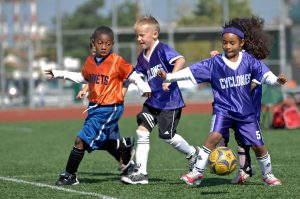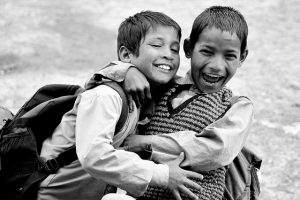Play and Peers
Learning Objectives: The Role of Play in Development
- Describe Erikson’s fourth stage of industry vs. inferiority.
- Define play.
- Describe the six types of play that emerge over time.
- Define pretend play and describe how it contributes to development.
- Describe the ways that children benefit from play.
- Explain how we can promote healthy play.
Developmental Task of Middle Childhood: Industry vs. Inferiority
According to Erikson, children in middle and late childhood are very busy or industrious (Erikson, 1982). They are constantly doing, planning, playing, getting together with friends, and achieving. This is a very active time, and a time when they are gaining a sense of how they measure up when compared with peers. Erikson believed that if these industrious children can be successful in their endeavors, they will get a sense of confidence for future challenges. If instead, a child feels that they are not measuring up to their peers, feelings of inferiority and self-doubt will develop. These feelings of inferiority can, according to Erikson, lead to an inferiority complex that lasts into adulthood. To help children successfully negotiate this stage, they should be encouraged to explore their abilities. They should be given authentic feedback as well. Failure is not necessarily a horrible thing according to Erikson. Indeed, failure is a type of feedback which may help a child form a sense of modesty. A balance of competence and modesty is ideal for creating a sense of competence in the child.
The Role of Play in Development

What is Play? Play is spontaneous fun activity found at all ages and in all cultures. Play begins in infancy. Freud analyzed play in terms of emotional development. Vygotsky and Piaget saw play as a way for children to develop their intellectual abilities (Dyer & Moneta, 2006). Piaget called play “a child’s work.” Subsequent research has shown that play provides many positive outcomes for children in all domains of development. The activity of play provides children opportunities to exercise all their developing capacities: physical, cognitive, emotional, and social. Play is spontaneous; children are intrinsically motivated to play. Play may be done alone or with others. It often involves pretending and make-believe.
Types of Play. In a classic study, Parten (1932) observed two to five-year-old children and noted six types of play: Three labeled as non-social play (unoccupied, solitary, and onlooker) and three categorized as social play (parallel, associative, and cooperative). The following Table describes each type of play. Younger children engage in non-social play more than older children; by age five associative and cooperative play are the most common forms of play (Dyer & Moneta, 2006).
Table 6.1 Parten's Classification of Types of Play in Preschool Children
| Category | Description |
|---|---|
| Unoccupied Play | Children's behavior seems more random and without a specific goal. This is the least common form of play. |
| Solitary Play | Children play by themselves, do not interact with others, nor are they engaging in similar activities as the children around them. |
| Onlooker Play | Children are observing other children playing. They may comment on the activities and even make suggestions, but will not directly join the play. |
| Parallel Play | Children play alongside each other, using similar toys, but do not directly act with each other. |
| Associative Play | Children will interact with each other and share toys, but are not working toward a common goal. |
| Cooperative Play | Children are interacting to achieve a common goal. Children may take on different tasks to reach that goal. |
adapted from Paris, Ricardo, & Rymond, 2019
Pretend Play. Pretense is a familiar characteristic of play. Pretend play can be combined with physical play or playing with objects. When pretending, children act as-if; they engage in make-believe. Their words and actions are not literal, but evoke something beyond what is concretely present (Lillard, Lerner, Hopkins, Dore, Smith, and Palmquist, 2015). In his study of cognitive development, Piaget was interested in pretend play and he documented the way in which it involved symbolic thought, that is, the ability to have a symbol represent something in the real world. A toy, for example, has qualities beyond the way it was designed to function, and can be used to stand for a character or a completely different object. A banana can be used as a telephone. As seen in the study of early childhood, symbolic thought is an important capability developed at the end of the sensorimotor stage that paves the way for the development of language. But pretend play uses capabilities that go beyond symbolic thought and mental representation.

Pretend play also requires the use of fantasy and imagination (Sobel & Lillard, 2001). Imagination is distinct from, but jointly engaged during play with executive function, including the developing capabilities of memory, inhibition, and attention shifting (Carlson & White, 2013). A complex form of pretend play emerges in Parten’s last two stages, associative play, and cooperative play. This new form is sociodramatic play, which is make-believe play with others, involving objects and actions woven into some kind of imagined situation or story. It is often scaffolded in play with adults or older children. As the development of sociodramatic play progresses, children begin acting out roles. They use situated imaginary identities as the basis of action and to create story lines. Through the creation of settings, roles, and narrative, imagination is used to explore ideas about what follows what, and about how things unfold in the world (Deunk, Berenst, & De Glopper, 2008). Perspective taking is improved through this social form of pretend play. Emotional development also is also fostered by sociodramatic play, as children choose imagined interpretations and responses to imagined emotions in pretend situations, and responds to emotions that arise in actual conflict generated between playmates. Perspective taking and dealing with emotions during pretend play contribute to the development of self-regulation (Gioia & Tobin, 2020).
Benefits of Play
“Play in all its rich variety is one of the highest achievements of the human species,” says Dr. David Whitebread from Cambridge University’s Faculty of Education. “It underpins how we develop as intellectual, problem-solving, emotional adults and is crucial to our success as a highly adaptable species.” International bodies like the United Nations and the European Union have begun to develop policies concerned with children’s right to play, and to consider implications for leisure facilities and educational programs.
Thanks to the Centre for Research on Play in Education, Development and Learning (PEDaL) at Cambridge, Whitebread, Baker, Gibson and a team of researchers are accumulating evidence on the role played by play in how a child develops. “A strong possibility is that play supports the early development of children’s self-control,” explains Baker, “. . . our abilities to develop awareness of our own thinking processes.” If playful experiences do facilitate this aspect of development, say the researchers, it could be extremely significant for educational practices because the ability to self-regulate has been shown to be a key predictor of academic performance.
Gibson adds: “Playful behaviour is also an important indicator of healthy social and emotional development. In my previous research, I investigated how observing children at play can give us important clues about their well-being and can even be useful in the diagnosis of neurodevelopmental disorders like autism.”
Source: Plays the Thing, Cambridge University https://www.cam.ac.uk/research/features/plays-the-thing is licensed under a CC BY 4.0
Sports and Physical Education

Middle childhood seems to be a great time to introduce children to organized sports, and in fact, many parents do. Nearly 3 million children play soccer in the United States (United States Youth Soccer, 2012). This activity promises to help children improve athletically, learn a sense of competition, and build social skills. However, it has been suggested that the emphasis on competition and athletic skill can be counterproductive and lead children to grow tired of the game and want to quit. In many respects, it appears that children's activities are no longer children's activities once adults become involved and approach the games as adults rather than children. The U. S. Soccer Federation recently advised coaches to reduce the amount of drilling engaged in during practice and to allow children to play more freely and to choose their own positions. The hope is that this will build on their love of the game and foster their natural talents.
Sports are important for children. Children’s participation in sports has been linked to:
- Higher levels of satisfaction with family and overall quality of life in children
- Improved physical and emotional development
- Better academic performance
Yet, a study on children’s sports in the United States (Sabo & Veliz, 2008) has found that gender, poverty, location, ethnicity, and disability can limit opportunities to engage in sports. Girls were more likely to have never participated in any type of sport. They also found that fathers may not be providing their daughters as much support as they do their sons. While boys rated their fathers as their biggest mentors who taught them the most about sports, girls rated coaches and physical education teachers as their key mentors. Sabo and Veliz also found that children in suburban neighborhoods had a much higher participation of sports than boys and girls living in rural or urban centers. In addition, Caucasian girls and boys participated in organized sports at higher rates than minority children.
Students don’t always persist in their participation in extracurricular and other organized sports activities. Sabo and Veliz asked children who had dropped out of organized sports why they left. For both girls and boys, the number one answer was that it was no longer any fun (see Table 6.2). According to the Sport Policy and Research Collaborative (SPARC) (2013), almost 1 in 3 children drop out of organized sports, and while there are many factors involved in the decisions to drop out, one suggestion has been the lack of training that coaches of children’s sports receive may be contributing to this attrition (Barnett, Smoll & Smith, 1992). Several studies have found that when coaches receive proper training, the drop-out rate is about 5% instead of the usual 30% (Fraser-Thomas, Côté, & Deakin, 2005; SPARC, 2013).
Table 6.2 Top Reasons Dropped Out or Stopped Playing Organized/Team Sports
| Girls | Boys | ||
|---|---|---|---|
| I was not having fun | 38% | I was not having fun | 39% |
| I wanted to focus more on studying and grades | 36% | I had a health problem or injury | 29% |
| I had a health problem or injury | 27% | I wanted to focus more on studying and grades | 26% |
| I wanted to focus more on other clubs or activities | 22% | I did not like or get along with the coach | 22% |
| I did not like or get along with the coach | 18% | I wanted to focus more on other clubs or activities | 18% |
| I did not like or get along with others on the team | 16% | I did not like or get along with others on the team | 16% |
| I was not a good enough player | 15% | I was not a good enough player | 15% |
| My family worried about me getting hurt or injured while playing sports | 14$ | My family worried about me getting hurt or injured while playing sports | 12% |
Source: Sabo, D., & Veliz, P. (2008). Go Out and Play: Youth Sports in America. East Meadows, NY: Women’s Sports
Physical Education. For many children, physical education in school is a key component in introducing children to sports and regular physical activity. After years of schools cutting back on physical education programs, there has been a turnaround, prompted by concerns over childhood obesity and related health issues. Despite these changes, currently only the state of Oregon and the District of Columbia meet PE guidelines of a minimum of 150 minutes per week of physical activity in elementary school and 225 minutes in middle school (SPARC, 2016). There is also controversy about physical education. Some experts recommend changing the content of these classes. Training on competitive sports, often a high priority, is unlikely to reach the least physically fit youngsters. Instead, programs could emphasize cooperation, enjoyable informal games, and individual exercise.
Learning Objectives: Friendships and Peer Relationships
- Identify three research traditions that study children’s relationships with agemates.
- Describe differences in boys’ and girls’ friendships.
- Describe benefits of friendship. How do friendships differ from peer relationships?
- Describe sociometric assessment. Identify the categories of sociometric status and describe how children in these categories differ from each other.
Friendship and Peer Relationships
Friendships and peer relationships are voluntary associations characterized by some degree of simalarity and affiliation. Three research traditions focus on the study of friendship and peer relationships. First, there is the study of friendships, which are dyadic relationships involving closeness and reciprocity. Second, another tradition studies groups of affiliated peers. In adolescence, these include cliques and crowd. Third, a separate tradition researches agemate status and popularity, a tradition known as sociometrics. Let’s look at each of these separately.
Friendship

As toddlers, children may begin to show a preference for certain playmates (Ross & Lollis, 1989). However, peer interactions at this age often involve more parallel play rather than intentional social interactions (Pettit, Clawson, Dodge, & Bates, 1996). By age four, many children use the word “friend” when referring to certain children and do so with a fair degree of stability (Hartup, 1983). However, among young children “friendship” is often based on proximity, such as they live next door, attend the same school, or it refers to whomever they happen to be playing with at the time (Rubin, 1980).
Friendships take on new importance to one's feelings of worth, competence, and attractiveness in middle and late childhood. Friendships provide the opportunity for learning social skills, such as how to communicate with others and how to negotiate differences. Children get ideas from one another about how to perform certain tasks, how to gain popularity, what to wear or say, and how to act. This society of children marks a transition from a life focused on the family to a life concerned with peers. During middle and late childhood, peers play an increasingly important role. For example, peers play a key role in a child's self-esteem at this age as any parent who has tried to console a rejected child will tell you. No matter how complimentary and encouraging the parent may be, being rejected by friends can only be remedied by renewed acceptance. Children’s conceptualization of what makes someone a “friend” changes from a more egocentric understanding to one based on mutual trust and commitment. Both Bigelow (1977) and Selman (1980) believe that these changes are linked to advances in cognitive development.
Bigelow and La Gaipa (1975) outline three stages in children’s conceptualizations of friendship. In stage one, reward-cost, friendship focuses on mutual activities. Children in early, middle, and late childhood all emphasize similar interests as the main characteristics of a good friend. Stage two, normative expectation focuses on conventional morality; that is, the emphasis is on a friend as someone who is kind and shares with you. Clark and Bittle (1992) found that, compared to third or eighth graders, fifth graders emphasized this more in a friend. In the final stage, empathy and understanding, friends are people who are loyal, committed to the relationship, and share intimate information. Clark and Bittle (1992) reported eighth graders emphasized this most in a friend. They also found that as early as fifth grade, girls were starting to include sharing of secrets, and not betraying confidences as crucial to someone who is a friend.
Selman (1980) outlines five stages of friendship from early childhood through to adulthood:
- Momentary physical interaction, a friend is someone who you are playing with at this point in time. Selman notes that this is typical of children between the ages of three and six. These early friendships are based more on circumstances (e.g., a neighbor) than on genuine similarities.
- One-way assistance, a friend is someone who does nice things for you, such as saving you a seat on the school bus or sharing a toy. However, children in this stage, do not always think about what they are contributing to the relationships. Nonetheless, having a friend is important and children will sometimes put up with a not so nice friend, just to have a friend. Children as young as five and as old as nine may be in this stage.
- Fair-weather cooperation, children are very concerned with fairness and reciprocity, and thus, a friend is someone returns a favor. In this stage, if a child does something nice for a friend there is an expectation that the friend will do something nice for them at the first available opportunity. When this fails to happen, a child may break off the friendship. Selman found that some children as young as seven and as old as twelve are in this stage.
- Intimate and mutual sharing, typically between the ages of eight and fifteen, a friend is someone who you can tell them things you would tell no one else. Children and teens in this stage no longer “keep score” and do things for a friend because they genuinely care for the person. If a friendship dissolves in the stage it is usually due to a violation of trust. However, children in this stage do expect their friend to share similar interests and viewpoints and may take it as a betrayal if a friend likes someone that they do not.
- Autonomous interdependence, a friend is someone who accepts you and that you accept as they are. In this stage children, teens, and adults accept and even appreciate differences between themselves and their friends. They are also not as possessive, so they are less likely to feel threatened if their friends have other relationships or interests. Children are typically twelve or older in this stage.
Peer Groups
In addition to their friendships, children also interact with other children their own age, referred to as peers. Peers include children encountered at school, in the neighborhood, or through family associations. Not all peers are friends. Some are acquaintances, and others are non-affiliated, but still part of the social context. Collections of peers that hang out or repeatedly engage in joint activities are referred to as peer groups, or cliques.
Sociometrics and Popularity
Sociometric assessment measures social status and acceptance among members of a group, such as a classroom of students. In sociometric research children are asked to mention the three children they like to play with the most, and those they do not like to play with. The number of times a child is nominated for each of the two categories (like, do not like) is tabulated. Popular children receive many votes in the “like” category, and very few in the “do not like” category. In contrast, rejected children receive more unfavorable votes, and few favorable ones. Controversial children are mentioned frequently in each category, with several children liking them and several children placing them in the "do not like" category. Neglected children are rarely mentioned in either category, and the average child has a few positive votes with very few negative ones (Asher & Hymel, 1981).

Most children want to be liked and accepted by their friends. Some popular children are nice and have good social skills. These popular-prosocial children tend to do well in school and are cooperative and friendly. Popular-antisocial children may gain popularity by acting tough or spreading rumors about others (Cillessen & Mayeux, 2004). Rejected children are sometimes excluded because they are rejected-withdrawn. These children are shy and withdrawn and are easy targets for bullies because they are unlikely to retaliate when belittled (Boulton, 1999). Other rejected children are rejected-aggressive and are ostracized because they are aggressive, loud, and confrontational. The aggressive-rejected children may be acting out of a feeling of insecurity. Unfortunately, their fear of rejection only leads to behavior that brings further rejection from other children. Children who are not accepted are more likely to experience conflict, lack confidence, and have trouble adjusting (Klima & Repetti, 2008; Schwartz, Lansford, Dodge, Pettit, & Bates, 2014).
Long-Term Consequences of Popularity. Childhood popularity researcher Mitch Prinstein has found that likability in childhood leads to positive outcomes throughout one’s life (as cited in Reid, 2017). Adults who were accepted in childhood have stronger marriages and work relationships, earn more money, and have better health outcomes than those who were unpopular. Further, those who were unpopular as children, experienced greater anxiety, depression, substance use, obesity, physical health problems and suicide. Prinstein found that a significant consequence of unpopularity was that children were denied opportunities to build their social skills and negotiate complex interactions, thus contributing to their continued unpopularity. Further, biological effects can occur due to unpopularity, as social rejection can activate genes that lead to an inflammatory response.
Supplemental Materials
- This video gives a brief history and significance of jump rope, particularly for Black girls in the U.S.
References
Asher, S. R., & Hymel, S. (1981). Children's social competence in peer relations: Sociometric and behavioral assessment. In J. K. Wine & M. D. Smye (Eds.), Social competence (pp. 125-157). New York: Guilford Press.
Barnett, N. P., Smoll, F. L., & Smith, R. E. (1992). Effects of enhancing coach-athlete relationships on youth sport attrition. The Sport Psychologist, 6, 111-127.
Bigelow, B. J. (1977). Children’s friendship expectations: A cognitive developmental study. Child Development, 48, 246–253.
Bigelow, B. J., & La Gaipa, J. J. (1975). Children’s written descriptions of friendship: A multidimensional analysis. Developmental Psychology, 11(6), 857-858.
Boulton, M. J. (1999). Concurrent and longitudinal relations between children's playground behavior and social preference, victimization, and bullying. Child Development, 70, 944-954.
Carlson, S. M., & White, R. E. (2013). Executive function, pretend play, and imagination. In The Oxford handbook of the development of imagination (pp. 161–174). Oxford University Press.
Cillessen, A. H., & Mayeaux, L. (2004). From censure to reinforcement: Developmental changes in the association between aggression and social status. Child Development, 75, 147-163.
Clark, M. L., & Bittle, M. L. (1992). Friendship expectations and the evaluation of present friendships in middle childhood and early adolescence. Child Study Journal, 22, 115–135.
Deunk, M., Berenst, J., & De Glopper, K. (2008). The development of early sociodramatic play. Discourse Studies, 10(5), 615–633.
Dyer, S., & Moneta, G. B. (2006). Frequency of parallel, associative, and cooperative play in British children of different socio-economic status. Social Behavior and Personality, 34(5), 587-592.
Erikson, E. (1982). The life cycle completed. NY: Norton & Company.
Fraser-Thomas, J. L., Côté, J., & Deakin, J. (2005). Youth sport programs: An avenue to foster positive youth development. Physical Education & Sport Pedagogy, 10, 19-40.
Gioia, K. A., & Tobin, R. M. (2010). Role of sociodramatic play in promoting self-regulation. In Play therapy for preschool children (pp. 181–198). American Psychological Association.
Klima, T., & Repetti, R. L. (2008). Children’s peer relations and their psychological adjustment: Differences between close friends and the larger peer group. Merrill-Palmer Quarterly, 54, 151-178.
Lillard, A. S., Lerner, M. D., Hopkins, E. J., Dore, R. A., Smith, E. D., & Palmquist, C. M. (2013). The impact of pretend play on children’s development: A review of the evidence. Psychological Bulletin, 139(1), 1–34.
Parten, M. B. (1932). Social participation among preschool children. Journal of Abnormal and Social Psychology, 27, 243-269.
Pettit, G. S., Clawson, M. A., Dodge, K. A., & Bates, J. E. (1996). Stability and change in peer-rejected status: The role of child behavior, parenting, and family ecology. Merrill-Palmer Quarterly, 42(2), 267-294.
Reid, S. (2017). 4 questions for Mitch Prinstein. Monitor on Psychology, 48(8), 31-32.
Ross, H. S., & Lollis, S. P. (1989). A social relations analysis of toddler peer relations. Child Development, 60, 1082-1091.
Rubin, R. (1980). Children’s friendships. Cambridge, MA: Harvard University Press.
Sabo, D., & Veliz, P. (2008). Go out and play: Youth sports in America. East Meadow, NY: Women’s Sports Foundation .
Schwartz, D., Lansford, J. E., Dodge, K. A., Pettit, G. S., & Bates, J. E. (2014). Peer victimization during middle childhood as a lead indicator of internalizing problems and diagnostic outcomes in late adolescence. Journal of Clinical Child and Adolescent Psychology, 44, 393-404.
Selman, R. L. (1980). The growth of interpersonal understanding. London: Academic Press.
Sobel, D. M., & Lillard, A. S. (2001). The impact of fantasy and action on young children’s understanding of pretence. British Journal of Developmental Psychology, 19(1), 85–98.
Sport Policy and Research Collaborative (SPARC, 2013). What is the status of youth coach training in the U.S.? University of Florida. Retrieved from https://assets.aspeninstitute.org/content/uploads/files/content/upload/Project%20Play%20Research%20Brief%20Coaching%20Education%20--%20FINAL.pdf
Sport Policy and Research Collaborative (SPARC, 2016). State of play 2016: Trends and developments. The Aspen Institute. Retrieved from https://www.aspeninstitute.org/publications/state-play-2016-trends-developments/
United States Youth Soccer. (2012). US youth soccer at a glance. Retrieved from http://www.usyouthsoccer.org/media_kit/ataglance/
OER Attributions:
"Lifespan Development: A Psychological Perspective, Second Edition" by Martha Lally and Suzanne Valentine-French is licensed under a CC-BY-NC-SA-3.0
Lifespan Development by Lumen Learning is licensed under a Creative Commons Attribution 4.0 International License
Child Growth and Development by College of the Canyons, Jennifer Paris, Antoinette Ricardo, and Dawn Rymond and is used under a CC BY 4.0 international license
Plays the Thing, Cambridge University is licensed under a CC BY 4.0
Additional written material by Dan Grimes & Brandy Brennan, Portland State University, and is licensed CC-BY-NC-SA-4.0
Video Attributions:
How the jump rope got its rhythm by TED is licensed CC-BY-NC-ND 4.0
Media Attributions
- peter-idowu-xA0HEsQTcpc-unsplash © Peter Idowu is licensed under a CC0 (Creative Commons Zero) license
- soraya-irving-9UEu-pyGOJU-unsplash © Soraya Irving is licensed under a CC0 (Creative Commons Zero) license
- sports
- aman-shrivastava-w6caoaJzXIE-unsplash © Aman Shrivastava is licensed under a CC0 (Creative Commons Zero) license
- benjamin-voros-RGLGPcMr19Y-unsplash © Benjamin Voros is licensed under a CC0 (Creative Commons Zero) license

